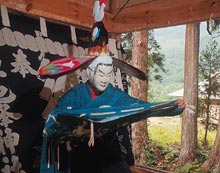
| Classification | Kagura |
|---|---|
| name | Take Kagura (Take Kagura) |
| alias | Hayaike Mine Kagura |
| Designated date | May 4, 1959 |
| Holding group | Takeru Kagura Preservation Association |
| location | Hanasaki-shi, Osako-cho Uchikawame |
| home page | Hanamaki |
watch video
Fuhou
Chicken dance
Overview
It is dedicated to the annual festival of Hayaikemine Shrine in Kagura, which is handed down to the Take district of Osako-cho, Hanamaki-shi. This Kagura is said to have been played by Yamabushi Osamu, who originally spoke to Hayaike Mine as a spiritual peak, but the origin of tradition has disappeared, and details are unknown. However, there are Kagura-den inscriptions in Chokyo 2 (1488) in Ogatsunai, which is said to have the same origin, and in the Hayaikemine Shrine, Gongen-sama in honor of Bunsei 4 (1595). It is considered to have been established at this time because Since the Meiji period, people have been handed down to the land, and now, in addition to the summer festival (July 31-August 1), it is also set as a stage of a private house at the end of the year. Gaku Kagura and Daigo Kagura go on a door-by-door basis while visiting the nearby neighborhood using the winter farming season (November-February) on a yearly basis, go to a door-to-door prayer, pray for no illness, and that night Every time he played Kagura (this is also called "Sakai Kagura" or "Samurai Kagura"). Kagura's performances consist of "dance", "outdoor dance", "Kyogen" and so on. "God dance" includes "chicken dance", "dance", "third dance", etc. There are other songs such as Mai, "Ara-mai", "Men-mai" and "Gongen-mai", and they have many songs. He specializes in brave and vigorous "wild dance" based on five rhythms.
Main performance place
Hayaikemine Shrine example festival (August), dance (December), dance beginning (January), etc.
